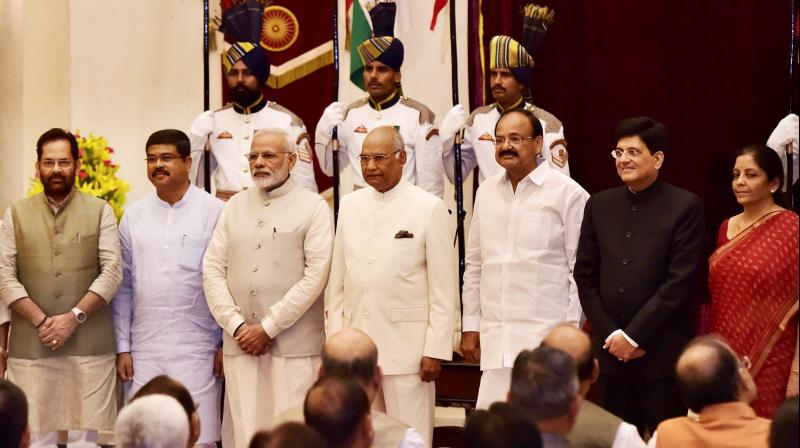Is optics enough to make Centre efficient?

Prime Minister Narendra Modi and BJP president Amit Shah remain the decision-makers: this was evident in the Cabinet expansion-reshuffle exercise on Sunday morning. First, Mr Modi had a breakfast meeting with the new entrants to the council of ministers early Sunday, and Mr Shah was there as well. Second, Mr Shah sat next to Mr Modi in the front row at Rashtrapati Bhavan. Usually, home minister Rajnath Singh, the Number 2 in the Cabinet and who would normally sit next to him, sat in the third chair. This can be dismissed as nothing of consequence but this is a visual clue to a government that seems to believe in working behind closed doors. This is not peculiar to the BJP, though. During the UPA years, then Prime Minister Manmohan Singh and Congress president Sonia Gandhi were the prime movers. Of course, the Congress’ politics were more intricate. Even Mrs Gandhi had to balance the many competing special interests as well as individuals. Mr Modi and Mr Shah manage a more streamlined organisation, where conspicuous lobbying is not entertained. There was a report in the morning’s papers that there was a huddle at Rajnath Singh’s place, attended by Arun Jaitley and Sushma Swaraj. It may well have been an informal meeting and Mr Singh, Mr Jaitley and Ms Swaraj may not have discussed anything significant about the Cabinet reshuffle.
The upgrading of four ministers of state with independent charge to Cabinet rank shows up the real problem that Mr Modi, Mr Shah and the BJP face. Dharmesh Pradhan (petroleum and natural gas), Piyush Goyal (power and energy), Nirmala Sitharaman (commerce) and Mukhtar Abbas Naqvi (minority affairs) had always been intelligent and diligent, and it would appear an act of condescension to “reward” their performance. It looks as if Mr Modi was hesitant about their abilities and he is now convinced they are indeed able. Remember, these are important ministries and it was necessary that they should have been given due importance by assigning them Cabinet ministers at the very beginning.So far, none of these ministers have not shown any great initiative in tackling the challenges each of them faces in their respective departments. The emphasis on generation of solar energy was that of the Prime Minister, and Mr Goyal paid enough attention to it. But he has not done anything impressive to improve the efficient management of power generation, transport and distribution networks in the country. It is possible he will put in quite a bit of his wonted energy into the Railways, but the task might require more innovative thinking than mere energy. Suresh Prabhu being assigned commerce appears to be a fair assignment, but it is not clear whether Mr Prabhu can tackle the difficult issues of trade policy. Nitin Gadkari gets river development and Ganga rejuvenation, that were with Uma Bharti. Does the reassignment mean dissatisfaction with Ms Bharti’s performance?Ms Sitharaman had been held back, or she has held herself back, from grappling with negotiations at the World Trade Organisation (WTO), and she has also been quite passive in terms of evolving a new industrial policy or even a modified exports policy. Will she be given enough freedom to handle the defence ministry, which is her new assignment? She is a person with a head on her shoulders, and before long she will master the intricacies concerning the armed forces, their operations and their needs. But will she dare to work to the long-term plan of strengthening the forces in terms of armaments? It remains a challenge to her and to this government. Despite its sabre-rattling, the Modi government has been quite shabby in attending to the building up of the strength of the armed forces.If this is the case, then bringing in bureaucrats like former home secretary R.K. Singh, former Mumbai police chief S.P. Singh, former Delhi Development Authority administrator K. Alphons and former diplomat Hardeep Singh Puri into the council of ministers poses the problem - how to deploy their expertise? It seems there is not much scope for these individuals to shape policy in any significant manner unless the Prime Minister has now realised he must listen to people outside the closed circle of the Prime Minister’s Office and that of national security adviser Ajit Doval. R.K. Singh and S.P. Singh may want to give their inputs on internal security, and Mr Puri on foreign policy. It must also be noted that many of these former bureaucrats have nothing to commend themselves than that they displayed pronounced right-wing attitudes and a certain affinity towards the BJP even when the party was not in power.Where Mr Modi and Mr Shah seem to be on a better footing was in choosing individuals with political credentials like Ashwini Kumar Chaubey from Bihar, Shiv Prakash Shukla (Uttar Pradesh), Virendra Kumar (Madhya Pradesh), Gajendra Singh Shekhawat (Rajasthan) and Anant Kumar Hegde (Karnataka), areas where the BJP is a force to reckon with.
The BJP is mostly in a self-congratulatory mood, and Prime Minister Modi leads the way. There is very little of self-criticism. They believe what they are doing is right and there is no need or scope for course correction. The expansion of the council of ministers is reduced to a routine exercise of filling vacancies. This government walks to the marching tune of slogans, and the slogan now is building a New India by 2022, whatever that means. There are no immediate, specific, short-term goals.There is, of course, one goal Mr Modi and Mr Shah are quite focused on: winning the 2019 Lok Sabha elections. They do not really consider the Cabinet reshuffle - and it’s being speculated this would be the last one before the election, and it very well could be so - as a preparation for winning the election. They feel the election will be won on Mr Modi’s popularity and not on the basis of the performance of the Modi government.

